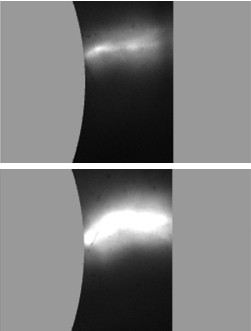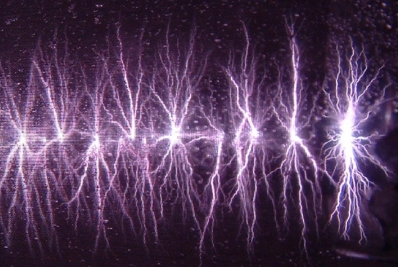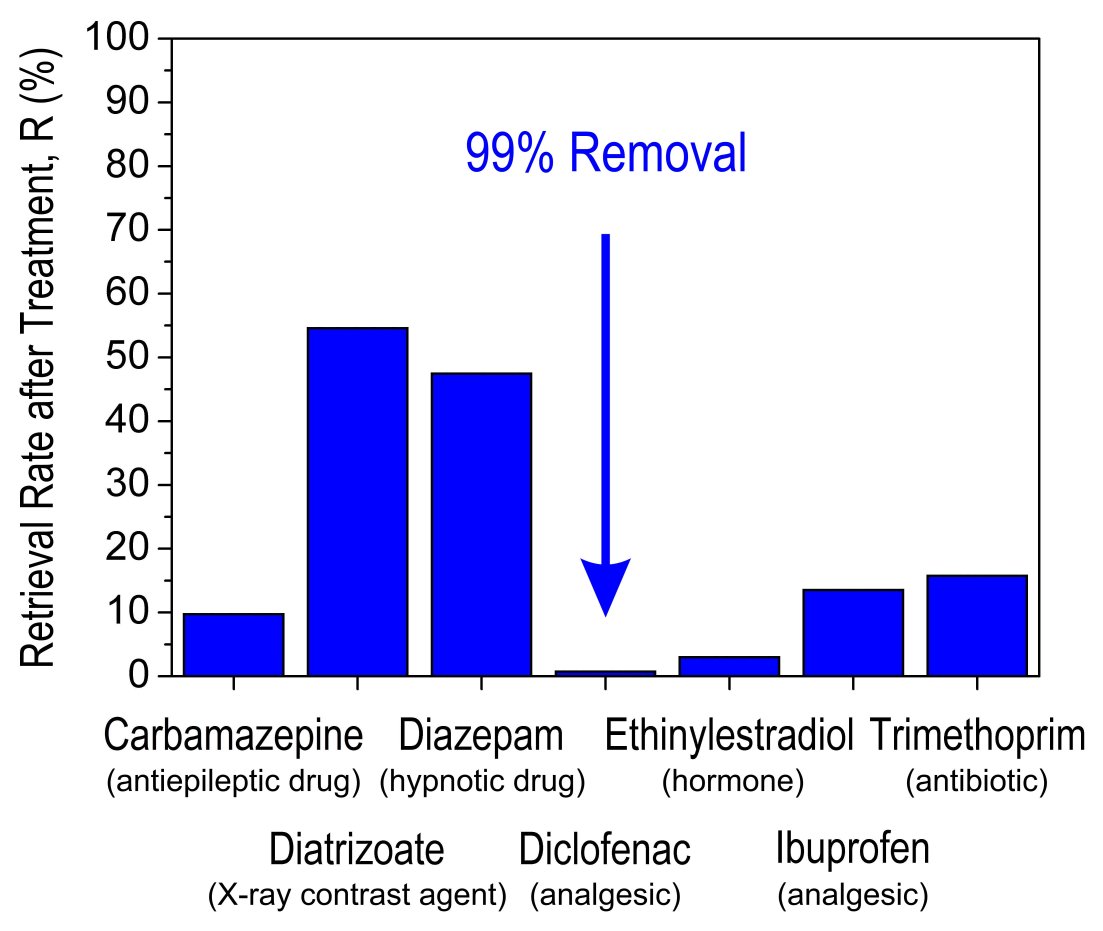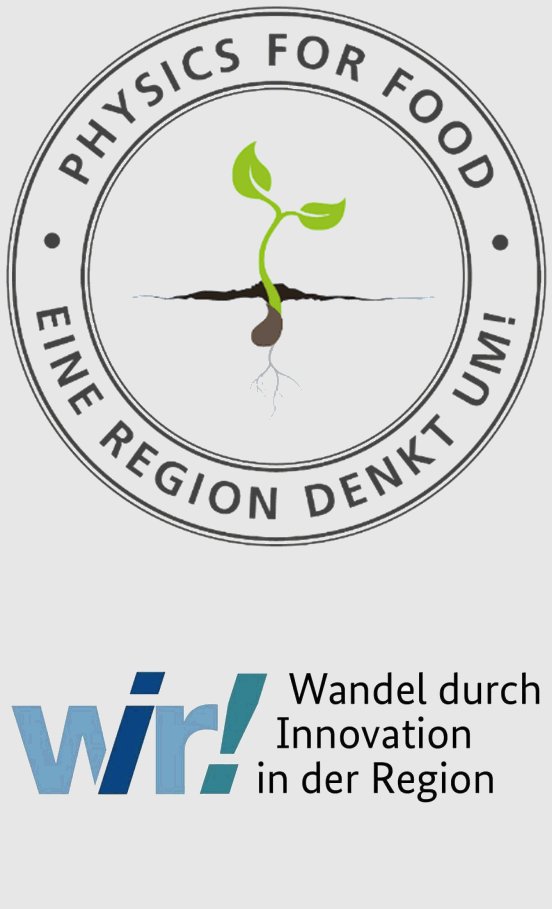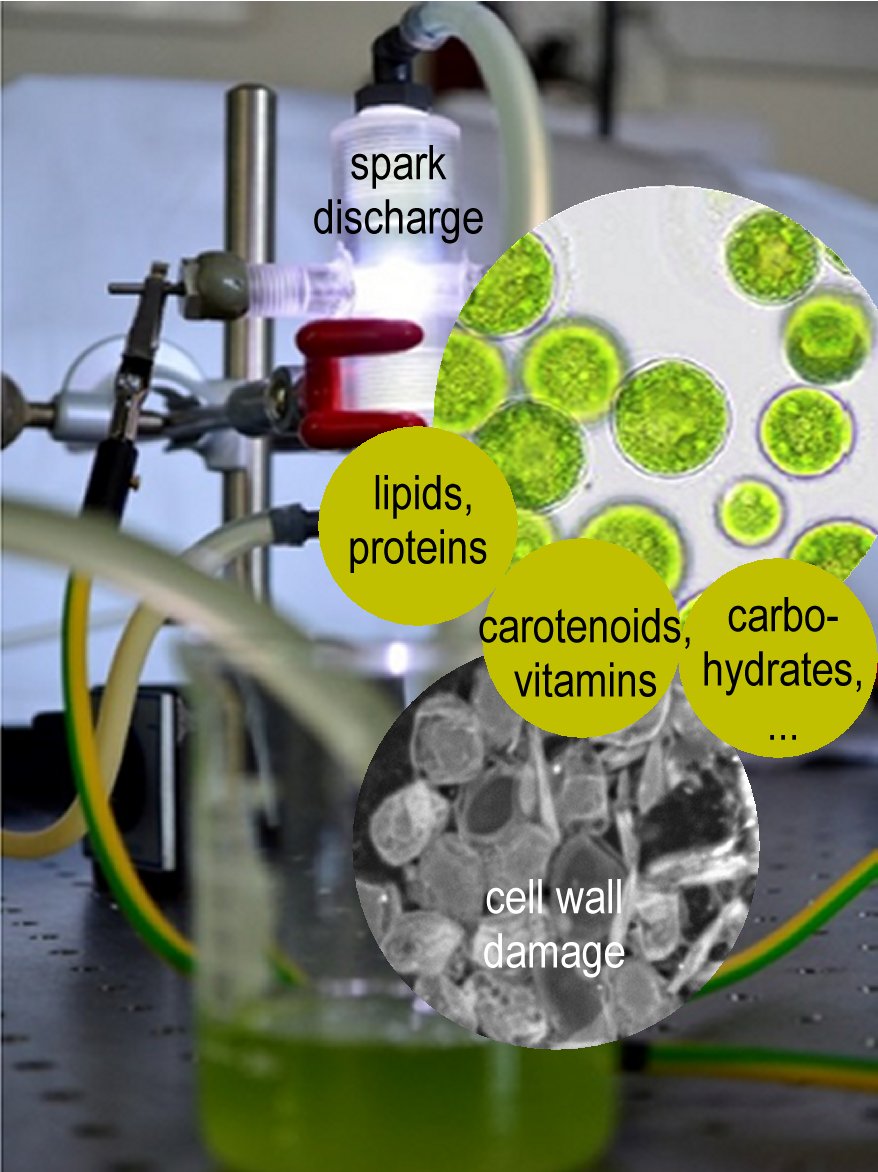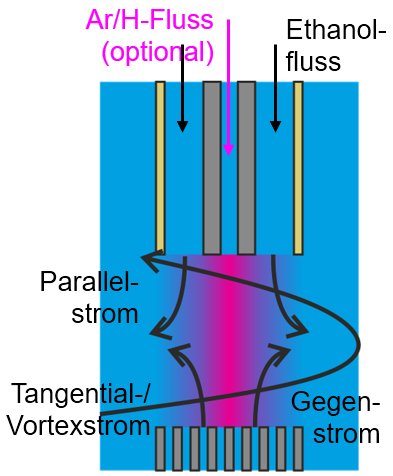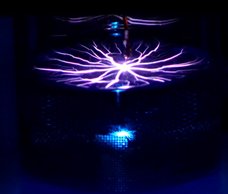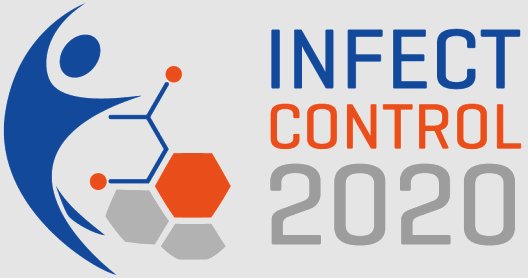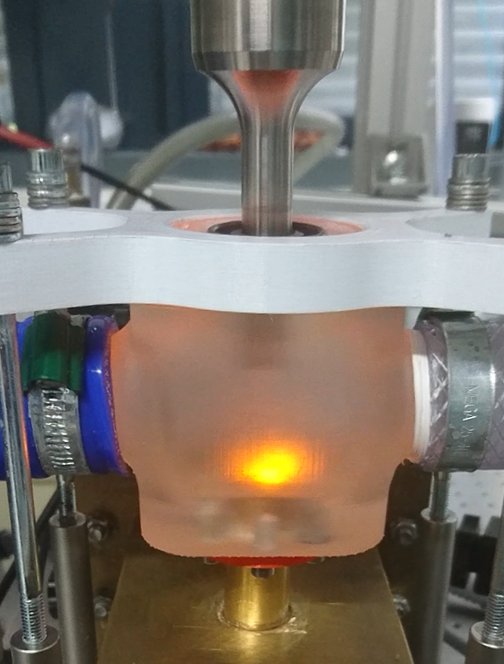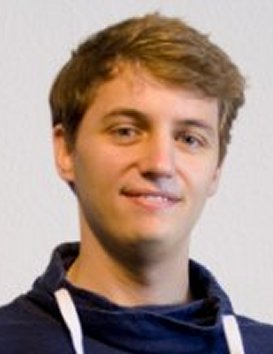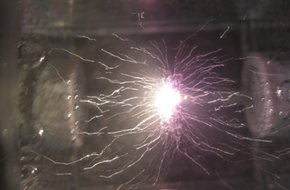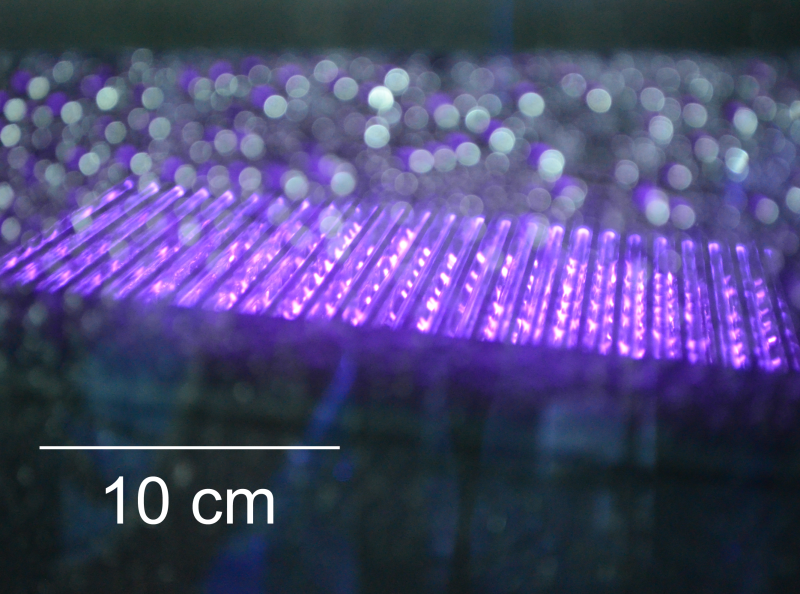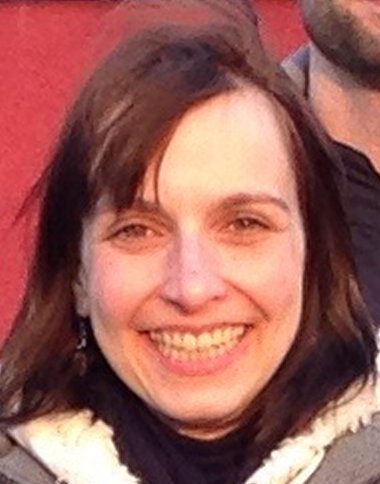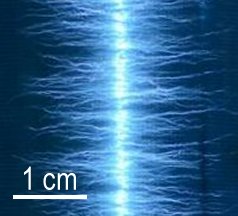Discharges for Pollutant Degradation, Chemical Synthesis, and Biomass Processing
Electrical breakdown in liquids has been a research topic for well over a century. While the understanding of insulating liquids often strives to avoid the phenomenon,
especially water and other polar liquids are investigated with the goal to take advantage of the mechanism.
One prevalent application is the switching of high voltages. Closing switches that use water as switching medium excel through high hold-off voltages of and fast closing times. Either depends on the geometry of the switch and the hold-off time, i.e. for how long the voltage is applied. Switching voltages as high as 4 MV have been demonstrated and some configurations have shown switching times on the order of 1 ns. Whereas electron avalanche ionization and streamer mechanisms were accepted within a few decades to explain the breakdown in gases, the nature of the breakdown in dielectric liquids is still disputed. In principle the dispute can be referred to two schools of thought. The first assumes the development of an initial gaseous phase, which then serves as the medium for avalanche development. Consequently, electrical breakdown in liquids is considered a 'shrouded gas discharge'. The alternate hypothesis states that a gaseous phase is not required and impact ionization in the liquid phase itself will result in a charge carrier multiplication, responsible for breakdown.
A major force, which is driving the interest in streamer discharges in water are the very promising applications for water purification. The potential of streamers for
the chemical and bacteriological decontamination stems from multiple interaction mechanisms that attack cells viruses and chemical contaminants alike. Four main agents
can be identified, which contribute, depending on target and ambient conditions, to varying degree to the efficacy of the treatment: strong electric fields in
particular at the streamer head, free radicals in particular hydroxyl and other oxidative species generated in the plasma, ultraviolet radiation from the plasma, and
shockwaves emanating from the discharge channel. How pronounced different mechanisms are, depends on ambient conditions, such as water-conductivity, but in particular also
how discharges are generated in the liquid, i.e. operating parameters of the applied high voltage pulses, i.e. pulse duration, pulse rise time and pulse amplitude.
In our research we investigate conditions and mechanisms of electrical breakdown in water for the application of short pulses of nanosecond duration. This regime is of
considerable interest in the design of pulse generators for a variety of applications ranging from inertial confinement fusion to the treatment of cancer. At the same
time an understanding of the physical response of the medium under extreme conditions of electric field and pulse duration is extremely interesting and challenging.
(For example not even the permittivity can be considered a constant any longer.)
Another direction of our research is the use of streamer discharges (i.e. the "progress" of electrical breakdown) in water for water purification and waste water treatment. As foremost physical attack agent, streamers are indiscriminate against biological and chemical agents and can be used against either of them accordingly and simultaneously. The method does further not involve any additional chemicals and is as a non-thermal process (at least theoretically) very efficient. In particular anthropogenic micropollutants (e.g. pharmaceuticals) are found in increasing concentrations in our drinking water and are raising concern. Obviously, state-of-the-art water treatment methods are not sufficient for their removal. Plasma can provide radicals which are able to break apart even the most recalcitrant substances. Accordingly, we are exploring the respective potential of different plasma methods.
|
 |
Projects
Removal of Chemicals in Farming and Crop Processing: Physics4Environment
→ click to expand/collapse to show/hide details Project funding: Federal Ministry for Education and Research (BMBF), since March 2021. Partner: Cosun Beet Company GmbH & Co. KG, Anklam; Harbauer GmbH, Berlin; Power Recycling Energyservice GmbH, Neubrandenburg.
The project is one of several individually funded actions in the WIR!-initiative "Physics for Food", which aims for a reduction and possible replacement of agrochemicals in farming and processing of crops.
(More information on other central actions and the overreaching goals of the entire initiative can be found here: Physics for Food.)
One of the most important objectives is the reduction of chemical plant protection agents by either replacing them with physical methods or at least by preventing their dissemination in the environment.
The latter is the particular aim of the central action "Physics for Environment". Since herbicides and pesticides are distributed in aqueous solutions and percolate into surface and ground water, accordingly, the initial
focus of the central action is the degradation of agrochemicals in drainage water but also wastewaters from farming activites and in the processing of harvests. The treatment of process water or the reuse of
wastewaters is of obvious and immediate economic significance and offers potential for improvement for many enterprises towards a more sustainable production. In many cases, simultaneaously a microbial reduction
needs to be achieved. Therefore, different methods for water treatment will be investigated, i.e. ultrafiltration, ozonation, UV-exposure, activated carbon filtration, but in particular also in combination with
more novel approaches, such as ultrasound and non-thermal plasma. It is our deliberate ambition to investigate these different methods in process relevant settings and to determine besides efficacies against
different chemical residues and microorganisms also economic constraints and to develop concepts for the implementation of the most succesful approaches for different needs.
Plasma-assisted reduction of CO2-reduction by aqueous phase synthesis
→ click to expand/collapse to show/hide details Doctoral Research Project, Sepideh Borghei, since September 2020.
The aim of the project is the investigation of the conversion of CO2 by reactions with water. However, this requires the activation of either CO2
or water - or both - to lower the respective energy barriers. Therfore, plasmas that can be generated either close to the liquid or submerged in water offer unique possibilities.
Besides the excitation and dissociation of CO2 in the plasma, different reactive species are formed from water molecules. While initially the reaction kinetics will
be studied, eventually also the efficiencies of the different processes will come into focus. Accordingly, also methods to increase the method, e.g. by introducing specific
catalysts, will be explored. Plasma porcesses will be studied together with the instigated chemical processes, accordingly.
Development of a plasma dissociation method for the efficent and gentle extraction of bioactive compounds from microalgae: PALEA
→ click to expand/collapse to show/hide details Project funding: German Federal Environmental Foundation (Deutsche Bundesstiftung Umwelt - DBU), since May 2020. Partner: Institut für Getreideverarbeitung (IGV) GmbH, Nuthetal.
The aim of the project is to damage or desintegrate the rather sturdy walls of microalgae which pevent the release of cellular contents. Therefore spark discharges that are generated
directly in the algal suspension have proven an effective method to inflict sufficient damage to allow for the release in particular of temperature sensitive compounds. The responsible
mechanism is the propagation of strong shockwaves that exceed the tensile strength of the microalgae by far. Conversly, no alteration of extracts by other plasma processes has been observed.
Moreover, the method is apparently indepent from the particular size of the treated microalgae which is often a problem with alternative extraction methods. Since also no solvents are needed,
the approach is inherently environmentally benign. Within the project the laboratory results will be transfered into the development of a model system for the treatment of algae suspensions grown
in photobioreactors on a larger scale with the goal to solve methodological and technological issues for the future application in downstreaming processes.
Investigation of the degradation of perfluorinated compounds by plasma treatment
→ click to expand/collapse to show/hide details Bachelor Research Project, Mira Buckstöver, April 2020 - October 2020. The aim of the project is to investigate the degradation of different perfluorinated compounds (PFCs) that are disolved in water by non-thermal plasma. Contaminated water is sprayed into the reaction volume of either a non-thermal pulsed discharge that is characterized by plasma filaments or a rather hot gliding arc discharge. Different operating parameters, such as operating gas and provided electrical power but also water parameters, such as conductivity and pH-value, are investigated. Experimental findings for a defined model system (distilled water) will be compared with degradation rates obtained for effluents from a waste water plant. First results indicate that different mechanisms are responsible for the observed decomposition of PFCs, depending on the plasma source and operating parameters. These will be studied in greater detail by HPLC-MS.
Optimization of a flow-through plasma reactor for the synthesis of graphene from bioethanol: Flo
→ click to expand/collapse to show/hide details Project funding: im Rahmen des Förderprogramms 'Zentrales Innovationsprogramm Mittelstand" des Bundesministeriums für Wirtschaft und Energie (BMWi), since April 2020. Partner: Zentrum für Brennstoffzellen Technik GmbH (ZBT), Duisburg.
The aim of the project is to investigate and eventually control the conditions for the flow of the liquid for the synthesis of high-quality graphene by a plasma that is submerged in bioethanol.
Therfore different concepts will be studied that provide a flow of the precursor into the reaction volume and of the synthesized graphene out of it. Hereby of particular interest is the interfacial
region. Fluid flow and plasma parameter will be investigated with respect to the quality of the product and quantity. Flow characteristics will especially be studied by particle image velocimetry to
determine pertinent conditions that will allow for the upscaling of the process. With the focus on bioethanol an enviromental friendly raw material has been identified that has shown significant
potential with respect to the synthesis of graphene by in-liquid plasma processing. In particular 2D-materials of only a few layers (even single layers) could be produced with higher efficiencies
in comparison with plasmas operated in gaseous environments.
Plasma-induced Degradation Mechanisms for Glyphosate-containing substrates: PIAG
→ click to expand/collapse to show/hide details Project funding: Leibniz-Wissenschaftscampus Phosphorforschung, August 2019 - December 2019. Partner: Institute of Soil Science, Department of Agricultural and Environmental Sciences, University of Rostock.
The aim of the project is to investigate and understand the mechanisms for the degradatin of glyphosate by plasma treatment. The probably most important agrochemical today is increasingly considererd problematic.
Therfore, further environmental distribution should not occur. Since percolation is the main distribution pathway, a remediation of glyphosate that is disolved in water is a promising approach. However, many
the substance is rather stable with respect to conventional water treatment technologies or require time-consuming methods and additional chemicals. Conversely, plasma treatments demonstrated an efficient
degradation. However, the interaction pathways and most beneficial plasma parameters or operating parameters, respectivley, are yet not understood. The investigation provided an evaluation of plasma methods with
respect to possible mechanisms and for the necessary further technological development.
Establishing a plasma-based method for the abatement of the proliferation of anitibiotic resistances through communal wastewaters: ANTIRES 2.0
→ click to expand/collapse to show/hide details Project funding: BMBF - InfectControl 2020 , August 2019 - December 2021 Partner: Institute of Marine Biotechnology (IMaB), University of Greifswald
The aim of the project is to investigate the potential of plasma-based treatment methods for wastewater to reduce their load with antibiotic resistant bacteria or at least diminish
their abilitiy to proliferate. For the latter a particular focus of the project was the resiliance of microorganisms that is expressed in their potentially altered proteomic profile.
The respective investigations by the Institute of Marine Biotechnology complements efforts to quantify inactivation rates. Different plasma methods were applied to either treat the water
directly or introduce plasma generated reactive species. The experiments were conducted for samples from a local wastewater treatment plant that were collected at different times through
different seasons of the year.
Investigation of TOC-parameters for surface- and wastewater before and after plasma treatment
→ click to expand/collapse to show/hide details Bachelor Research Project, Niklas Barthel, September 2018 - February 2019. The aim of the project was to evaluate the total organic carbon (TOC) as a summary parameter for the degree of organic pollution of water. The parameter allows a comprehensive evaluation of water qualities without the need of detailed information on the concentration of particular substances, such as pharmaceuticals. Regardless, or rather in particular therefore, is the respective analysis an important guide for any water treatment method. However, the measurement principle is based on an oxidation of the organic matter in the sample and for the nature of a plasma treatment, interaction mechanisms of the species that are generated by the plasma, and remaining in the water, with the measurment is possible. Accordingly, the possibilities of TOC-measurements for the plasma-treated water needed to be investigated. The results show that TOC-measurements can be used to determine degradatio efficiencies of plasma treatments. However, attention needs to be paid to possible reactions of the reactive species generated by the plasma and especially metal ions that could be introduced from the electrodes that were used for the generation of a discharge.
Development of a combination system for the targeted chemo-physical modification of constituents in suspension by ultrasound and cold plasma: Kombi-Max
→ click to expand/collapse to show/hide details Project funding: "im Rahmen der Richtlinie zur Förderung von Forschung, Entwicklung und Innovation des Landes Mecklenburg-Vorpommern", August 2018 - January 2021. Partner: Power, Recycling, Energyservice GmbH (PRE), Neubrandenburg; Agrar and Process Technology, University of Rostock.
The aim of the project is to increase the desintegration of biomass in biogas facilities and this way promote the better access of microorganisms (and eventually increase
the yield and efficiency of biogas production) by combining ultrasound treatment and plasma exposures. Ultrasound is already successfully used to rupture in particular
difficult plant material, however, the desintegration is still not complete. Plasma exposures can offer additional pathways, especially by providing potent reaction chemistries
in the biomass suspension. Furthermore it is likely that ultrasound and plasma treatment can mutually enhance the efficacy of the respective individual methods, potentially resulting
even in synergies. The plasma in the rather dense and viscous biomass substrate is generated by the delivery and focusing of microwaves, ideally into the ultrasound field,
With comparable electrical powers for plasma and generation and ultrasound irradiation, even rather robust substrates can be comprehensivly disintegrated.
Initiation and development of sub-microsecond discharges in water and relation to chemical processes
→ click to expand/collapse to show/hide details Doctoral Research Project, Raphael Rataj, since December 2017.
The aim of the project is a better understanding of the initiation and development of discharges that are generated in water by the application of short high voltage
pulses of nanosecond durations. For the initiation of particular interest is the dependence of pertinent pulse parameters, such as pulse duration and pulse amplitude.
Likewise crucial, and therefore often discussed but rarely systematically investigated, are pulse rise and fall times. Accordingly, pulse parameters and discharge
geometry are tightly controlled in the experiments to determine respective inception voltages and discharge developments.
Streamer-like filaments that are emerging during the application of a high voltage pulse, are subsquently re-illuminated in a way that strongly depends on pulse
fall times with emissions that can be even stronger than observed during the expansion phase of the discharge channels. This phenomenon can be related to the backflow
of charges into the filaments. It can be expected that the observed differences of the post-expansion phase characteristics affect the generation of reactive species.
Degradation of cylindrospermopsin using advanced non-thermal plasma technologies
→ click to expand/collapse to show/hide details Doctoral Research Project, Marcel Schneider, since May 2017.
Cyanobacterial toxins are natural toxins that are an increasing thread to drinking water supplies due to rising insitances of cyanobacterial blooms, especially during the hotter summer seasons.
The doctoral research is part of the European Training Network (ETN) NaToxAq, which is lead by the University of Copenhagen and dedicated to the study of "Natural Toxins and Drinking Water Quality -
From Source to Tap" (https://natoxaq.ku.dk/).
Marcel Schneider is a student at the Research Centre for Toxic Compounds in the Environment (RECETOX) at Masaryk University in Brno, Czech Republic, investigating the possibilities to degrade
cylindrospermopsin (one of the most prominent represantatives for cyanotoxins) by the application of non-thermal plasmas together with the INP in Greifswald. The focus is in particular a comparison
of pulsed dielectric barrier discharges that are operated in air, while contaminated water is sprayed into the plasma, and corona-like discharges that are generated directly in the water.
The latter method has already been successful for the abatement of recalcitrent pharmaceuticals in water. Besides degradation efficiencies, depending on operating parameters of the plasma, Marcel
has also studied in detail reaction pathways and associated chemistries of the fundamentally different approaches.
Economic synthesis of contamination-free graphene: PlasGraph
→ click to expand/collapse to show/hide details Project funding: im Rahmen des Förderprogramms 'Zentrales Innovationsprogramm Mittelstand" des Bundesministeriums für Wirtschaft und Energie (BMWi)'", April 2017 - July 2019.
The aim of the project was the investigation of possibilities for the generation of graphene from liquid precursors. This competitive new approach offers the general possibility for a cleaner and more
efficient production of mono- and few layer graphene. Therefore the most suitable organic liquids need to be determined, together with the an appropriate plasma process for the conversion of the precusors.
Especially aromatic compounds seem most promising. Depending on the molecular properties of these molecules and the general properties of the respective liquids, a plasma can either be applied at the
surface of the solvent or in the liquid directly. Relevant plasma-chemical reactions require further to control oxidation and reduction processes, which can be achieved by a dedicated operating gas atmosphere,
i.e. noble gases with and without the admixture of oxygen (or other oxidizing agents), ambient conditions, such as pressure and temperature, and - of course - plasma operating parameters. In particular decidedly
non-equilibrium plasmas, instigated by short high voltage pulses, offer possibilities to manage plasma and process parameters.
Optimization of the impulse-method for the application for drinking water treatment: OxIDANT
→ click to expand/collapse to show/hide details Project funding: EFRE Europäischen Fonds für regionale Entwicklung über die Sächsische Aufbaubank, April 2016 - September 2018. Partner: PICON GmbH, Dresden; Process Engineering in Hydrosystems, Technical University Dresden.
The aim of the project was to optimize a plasma discharge for drinking water treatment. A non-thermal, i.e. 'cold', plasma is generated by the repetitive
application of short high voltage pulses to a dedicated electrode geometry in an air-water mixtures. Therefore the water is sprayed by a nebulizer from
the top into the plasma configuration. Highly reactive species that are generated in the plasma can readily mix with the water and attack and degrad
undesired organic compounds. Especially hydroxyl radical are known to be relatively non-selective, i.e. preferential, with respect to different pollutants,
and react with all of them with high kinetics. As a result they are especially suitable for the remediation of recalcitrant organic substances. However,
hydroxyl radicals are rather short lived and hence strategies for their efficient delivery need to be devised. Experiments with respect to water treatment,
reactive species that are generated and possible by-products were conducted at the Technical University of Dresden. The INP has developed and build the
plasma system for these experiments as a subcontracter.
Extraction of Bioactive Primary and secondary metabolites from microalgae by atmospheric pressure plasmas and pulsed discharges in water
→ click to expand/collapse to show/hide details Doctoral Research Project, Katja Zocher, August 2015 - December 2019.
The aim of the project was the investigation of possibilities for 'gentle' methods for compounds from microalgae. Besides a source of lipids for biofuels, other components are in particular interesting
for the pharmaceutical industry and as a nutritional supplement. The problem of microalgae is their robust cell wall and the rather high energy demand of available extraction methods. Therefore alternative
approaches were investigated, such as pulsed electric field exposures but especially different plasma methods. Among the latter have spark discharges, that are generated directly in the algae suspension
by the application of short high voltage pulses of 100 ns, demonstrated to effectively damage cell walls and promote the release of cell contents. Arguably more important is also the possibility to control
the temperature increase in the suspension with this method and prevent the degradation of heat sensitive compounds. The responsible mechanism that was identfied are strong shockwaves, that result in
mechanical damage and allows to optimize the method accordingly. Nevertheless, the plasma treatment will also generate different reactive species, which might react with the extracted compounds. Therefore
also a careful study was conducted on a possible oxidation, nitrification or any other presumable change of different proteins of interest.
Pulsed plasma in water for the remediation of pharmaceutical residues: PlasWas
→ click to expand/collapse to show/hide details Project funding: BMBF als "Wissenschaftliches Vorprojekt", April 2015 - March 2017.
The aim of the project was to optimize a plasma discharge for drinking water treatment. A non-thermal, i.e. 'cold', plasma is generated by the repetitive
application of short high voltage pulses to a dedicated electrode geometry in an air-water mixtures. Therefore the water is sprayed by a nebulizer from
the top into the plasma configuration. Highly reactive species that are generated in the plasma can readily mix with the water and attack and degrad
undesired organic compounds. Especially hydroxyl radical are known to be relatively non-selective, i.e. preferential, with respect to different pollutants,
and react with all of them with high kinetics. As a result they are especially suitable for the remediation of recalcitrant organic substances. However,
hydroxyl radicals are rather short lived and hence strategies for their efficient delivery need to be devised. Experiments with respect to water treatment,
reactive species that are generated and possible by-products were conducted at the Technical University of Dresden. The INP has developed and build the
plasma system for these experiments as a subcontracter.
Nanosecond high voltage discharges in liquids for polymer modifications
→ click to expand/collapse to show/hide details Postdoctoral Research Project, Dr. Camelia Miron, July 2013 - May 2015.
The aim of the project was to invetigate the possiblities of nanosecond discharges in liquids, primarily aqueous solutions, for the modification and synthesis of new materials.
Experiments were focusing in particular on the application of very short high voltagepulses with durations of either 10 ns or 1 ns, and amplitudes of up to
of 150 kV or 200 kV, respectively. Novel mechanisms and interactions are associated with this extreme conditions. In organic liquds, few-layer graphene structures
could be synthesized and in aqueous electrolytes polymers could be effectively modified, i.e. functionalized. For polyimide films, treated
in the vicinity of the discharge, an increase in the degree of inter-molecular ordering of the polymer was observed that could held responsible for a decrease of the
relative permittivity. Concurrently, did the hydrophoicity of the polyimide films increase. The mechanisms of surface modification were notable different
from previousl described interactions with plasmas that wer generated with microsecond high voltage pulses.
Degradation of pharmaceutical residues by pulsed corona discharges generated directly in water
→ click to expand/collapse to show/hide details Doctoral Research Project, Robert Banaschik, February 2013 - November 2017.
The aim of the project was the study of degradation mechanisms of pharmaceutical residues in water for the treatment with corona-like discharges that were directly generated in the liquid. Therefore,
an extended rather 'cold' plasma was generated by the application of high voltage pulses of sub-microsecond duration to a thin wire at the center of a coaxial geometry. Depending on the operating parameters,
in particular water conductivity and pulse amplitude, the entire volume can be penetrated by a densly distributed plasma filaments. The potential of the method for the abatment of pharmaceuticals that are often
found in water and was shown for carbamazepine (anti-epilepsy drug), diatrizoate (X-ray contrast agent), diazepam (anxiety medication), diclofenac (pain medication), ibuprofen (pain medication), ethinylestradiol
(contraceptive) and trimethoprim (antibiotic). With the plasma that is generated from the water, especially high concentrations of hydroxyl radicals were produced. These were found to be responsible for
an efficient oxidation of even persistent compounds, such as X-ray contrast agents. This was shown in detail for the degradation of diclofenac by investigating degradation products and their subsequent
reactions with hydroxyl radicals. Accordingly, the entire degradation cascade, i.e. all intermediates until the complete mineralization of the initial compound could be determined together with the
respective reaction pathways. Notable, reactions with ozone are not relevant, which was actually not observed for the submerged results. However, in addition to the reaction with directly formed hydroxyl
radicals also post-discharge chemistries, i.e. Fento reactions, which could split up hydrogen peroxide again into hydroxyl radicals, were recognized as an important - so far neglected - mechanism
for the plasma treatment. Accordingly, the choice of electrod materials is a crucial factor for the optimization of the method in addition to operating parameters.
|
